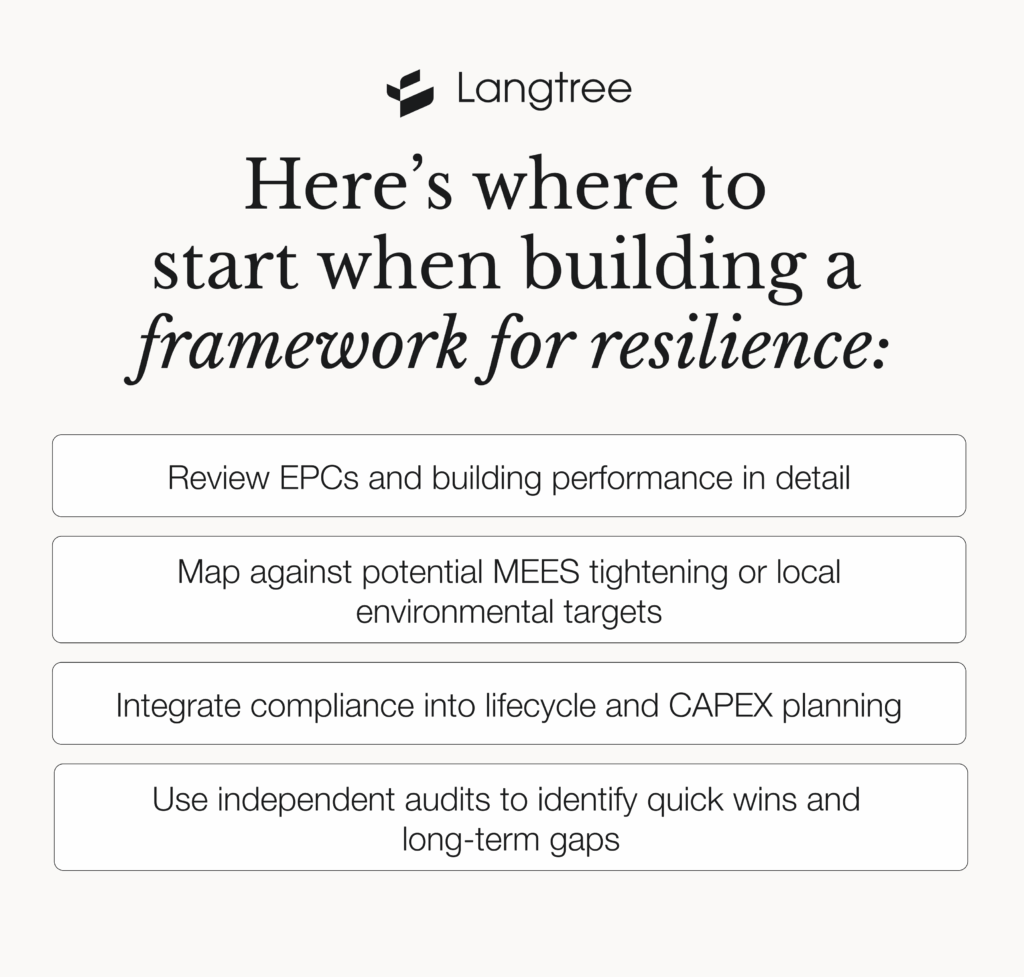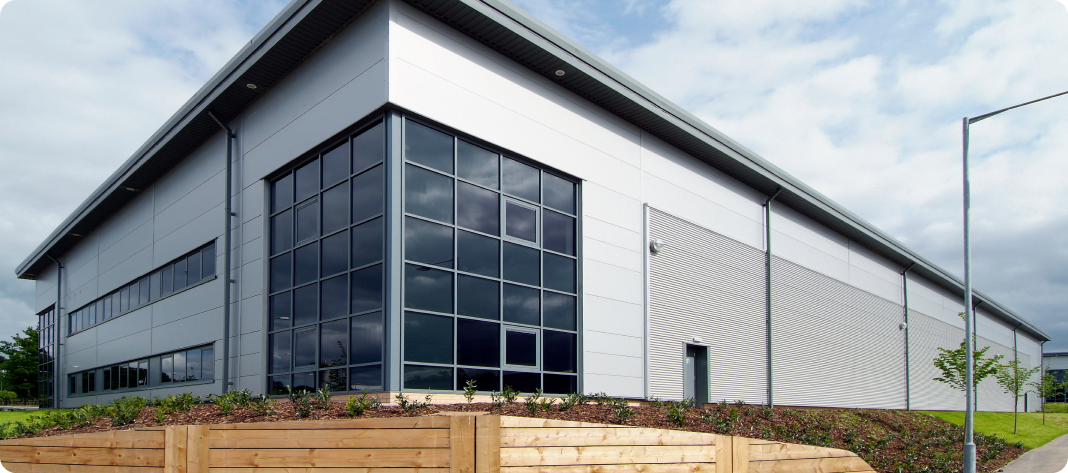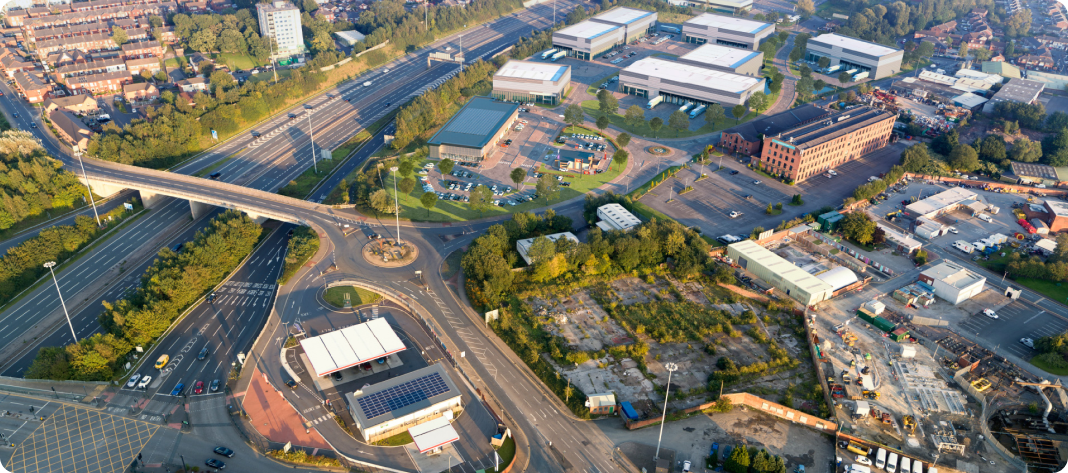Posted
September 29, 2025

Jayne Furnival
Executive Director – Property
jfurnival@langtreepp.co.uk EmailWith occupier needs evolving, regulations changing, and investors placing greater focus on asset performance, portfolio managers are under growing pressure to think beyond short-term delivery and plan for long-term resilience.
Preparing assets for the future means more than just ticking compliance boxes or upgrading to the latest technology. It requires a strategic, joined-up approach that balances long-term investment performance with operational delivery, tenant engagement, and environmental expectations.
At Langtree, we work across commercial and public sector portfolios, bringing together asset planning, property management and financial governance to help our clients navigate what’s next.
Here are three core strategies we believe will define future-ready property portfolios in the years ahead.
1. Build resilience through compliance and environmental planning
While sustainability may be treated as optional in some portfolios, investor and occupier expectations are rapidly changing.
Environmental performance, energy efficiency and transparent reporting are increasingly shaping funding, leasing and valuation decisions, and portfolio managers can view these shifts not simply as compliance rules but as signals to uncover value and effectively manage risk.
At the same time, commercial property regulations in the UK are tightening. The government has proposed increasing the Minimum Energy Efficiency Standards (MEES) to an EPC ‘B’ rating by 2030 for non-domestic buildings, with interim steps already being discussed. Properties that fall short could become unlettable or face restricted financing options.
Rather than react to these changes under pressure, leading managers are proactively reviewing asset readiness through environmental and compliance audits.
“Many property managers still treat compliance and sustainability as operational issues, rather than value drivers,” says Jayne Furnival, Executive Director – Property at Langtree. “But by building in environmental planning early, you avoid expensive retrofits and position the asset more favourably in the eyes of occupiers and lenders.”
Here’s where to start when building a framework for resilience:

- Review EPCs and building performance in detail.
Don’t just check that you have EPC certificates, you should review how old they are, whether plant upgrades have been captured, and where potential downgrades may occur as standards tighten. Commission updated assessments where gaps exist.
Why this matters: Outdated EPCs may not reflect current performance and can mask risk.
- Map against potential MEES tightening or local environmental targets.
Map your assets against the government’s proposed MEES trajectory (potential EPC B by 2030) as well as local authority or sector-specific environmental targets.
What this looks like in practice: Identify which assets could become unlettable under future standards and prioritise them for phased upgrades.
- Integrate compliance into lifecycle and CAPEX planning.
Factor retrofit and efficiency upgrades into your long-term maintenance cycles, rather than treating them as reactive costs. Align works with natural refurbishment points to reduce disruption and cost duplication.
Why this matters: A planned approach protects net operating income and makes capital expenditure more predictable.
- Use independent audits to identify quick wins and long-term gaps.
External audits can highlight both quick wins (e.g. low-cost energy efficiency tweaks) and more strategic risks (e.g. HVAC obsolescence or structural inefficiencies).
What this looks like: A roadmap showing which assets are performance leaders, which are lagging, and where investment will have the most impact.
This proactive approach positions you to take advantage of market shifts—rather than react under pressure.
2. Align your asset strategy with evolving occupier needs
Occupiers are changing fast. From hybrid workplaces to logistics companies chasing last-mile speed, businesses are rethinking the spaces they occupy and how those spaces need to function.
Modern tenants expect flexibility, smart infrastructure, and low-carbon credentials. But they also want properties that support wellbeing, productivity and efficiency. In industrial sectors, that might mean EV-ready parking and 24/7 operational permissions. In offices, it might be high-spec Wi-Fi, breakout space, and flexible lease terms.
Assets that can pivot swiftly are best equipped to retain tenants, maintain value, and reduce void periods.
Langtree supports this by bringing together tenant feedback, lease performance data, and building-level insight. That enables strategic conversations about repositioning, layout reconfiguration, or lease structuring in a way that anticipates tenant expectations.
This is especially relevant across our joint ventures, such as Sci-Tech Daresbury where public sector partners rely on us for operations, long-term investment direction, tenant risk monitoring, and lease strategy.
Considerations for future-fit portfolios:
- Flexibility of space and layout
Can your building adapt to multiple occupier models — from hybrid office working to logistics operators needing larger loading areas? Buildings that can be reconfigured with minimal disruption are more attractive to tenants in fast-changing markets. - Evolving occupier expectations
Are tenants asking for higher digital connectivity, wellbeing features (like air quality monitoring or green spaces), or energy-efficient infrastructure? Tracking these signals can help you anticipate demand before it becomes a condition of retention. - Lease structures and negotiation terms
Do your leases build in flexibility to accommodate short-term tenancies, break clauses, or green lease provisions? Reviewing clauses regularly ensures your agreements align with both compliance responsibilities and tenant expectations. - Opportunities during voids and lease expiries
When a unit becomes vacant or a lease is nearing expiry, can this moment be used to reposition the asset? For example, upgrading insulation, reconfiguring floorplates, or marketing to a new tenant sector. Treating voids as opportunities rather than risks can help refresh an asset’s market relevance. - Integration with long-term investment strategy
Do your asset-level decisions align with your wider portfolio objectives — such as balancing risk across tenant mix, preparing for refinancing, or meeting investor expectations? A joined-up view ensures individual property actions contribute to stronger overall performance.
How ready is your building for what’s next? Request a property management audit from Langtree to uncover risks, opportunities and long-term performance insights.
3. Leverage smart technology to support lifecycle planning
Tools like occupancy sensors, digital twins, smart meters and ESG dashboards are increasingly common in high-performing portfolios.
Occupancy sensors track how spaces are used to optimise lighting, heating and layouts; digital twins create virtual models of buildings to test scenarios before investing; and ESG dashboards pull data into clear reports for compliance and investor transparency.
Together, these tools help managers plan more effectively for both operational efficiency and long-term tenant satisfaction.
But technology only creates value when it’s embedded into the broader investment plan strategically. Installing complex systems that don’t connect with existing infrastructure, or investing in tools without using their data meaningfully, are common missteps.
Instead, align technology with your lifecycle goals: choose upgrades timed for CAPEX phases, funded through project budgets, and mapped to your reporting or tenant strategy.
Smart data can tell you when systems are inefficient, when tenant usage shifts warrant layout changes, or when compliance risk arises—guiding decisions from refurbishment to refinance.
Practical uses for smart tech in commercial property management:
- Benchmarking and comparing energy performance
Smart meters and building management systems (BMS) allow portfolio managers to compare performance across sites, spotting which assets are outliers. This helps prioritise investment where it will have the biggest impact on running costs and carbon reduction. - Early detection of inefficiencies and risks
IoT sensors can flag anomalies in heating, cooling, lighting, or equipment performance. For example, a sudden spike in energy use might signal a failing HVAC unit. Acting early avoids costly repairs, unplanned downtime, or tenant dissatisfaction. - Informing space planning and tenant experience
Occupancy sensors show how different areas of a building are used, helping to identify underutilised zones or areas in demand. This data can support decisions about reconfiguring layouts, adding breakout areas, or reallocating space to different tenant types. - Supporting compliance and reporting
ESG dashboards and automated reporting tools pull together data on energy use, emissions, and waste. These systems reduce the administrative burden of compliance while also demonstrating progress to investors, lenders, and occupiers who increasingly ask for transparency. - Strengthening long-term lifecycle planning
When linked with digital twin technology, smart data enables scenario modelling to test how different retrofit options, refurbishments, or tenant changes could affect building performance before committing capital. This gives portfolio managers confidence in decision-making and aligns upgrades with investment goals.
Future-ready assets start with better planning
Commercial portfolios that succeed over the next decade will be those that think strategically today. Whether it’s anticipating compliance risk, aligning with market shifts, or using data to plan smarter, the future of property management belongs to those who prepare for it.
Langtree’s property audit provides clarity on where your asset stands and how to close the gap between current performance and future expectations.
PLANNING AHEAD
Prepare your commectial property for long-term success
Book a tailored audit to assess regulatory risks, sustainability gaps, service costs and tenant-readiness.










